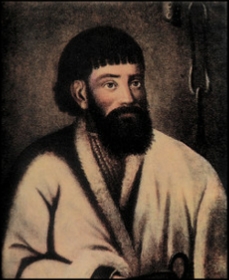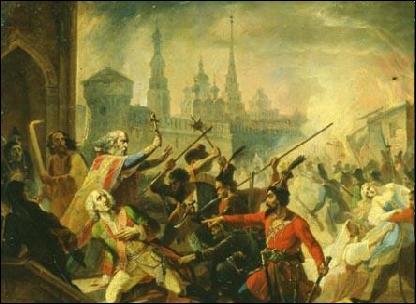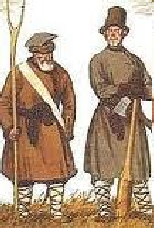


THE PUGACHEV REBELLION 1773 -
xxxxxThe peasant revolt against serfdom, beginning in the Volga region in 1773, proved a serious threat to the government of Russia's Catherine the Great. It was led by Yemelian Pugachev, a dissident Don Cossack. He claimed to be the Emperor Peter III (assassinated by Catherine, his wife, in 1762) and, promising the abolition of serfdom, assembled a large army -
 xxxxxThe Cossack and peasant rebellion of 1773, breaking out in the middle and lower Volga region, proved to be the greatest uprising in Russian history prior to the Bolshevik revolution of 1917. There had been earlier uprisings -
xxxxxThe Cossack and peasant rebellion of 1773, breaking out in the middle and lower Volga region, proved to be the greatest uprising in Russian history prior to the Bolshevik revolution of 1917. There had been earlier uprisings -
xxxxxThe leader of this revolt was Yemelian Ivanovich Pugachev, an illiterate Don Cassock and a former member of the Russian army. Aware of the growing hostility of his people against the oppression of the Moscow government, in 1773 he claimed to be Emperor Peter III (who had been deposed by his wife Catherine II and assassinated in 1762) and, declaring that his aim was to abolish serfdom, called for support. He did not call in vain. Within a short while he had gathered together a huge army of Cossacks, peasants, and mine and factory workers.

xxxxxIn the autumn of 1773 this force laid siege to Orenburg and Catherine, alarmed at the strength of this protest, sent an army under General Bibikov to stop and destroy the rebels. He defeated Pugachev at Tatishchevo, west of Orenburg, in the spring of 1774, but the rebel leader then advanced on Kazan, burning the city to the ground. Then, having crossed the Volga, he captured Saratov and, laying siege to Tsaritsyn, prepared to advance on Moscow. It was at this point, however, as we shall see, that the Russian victory over the Turks, sealed by the Treaty of Kuchuk Kainarji in July 1774, provided Catherine with the battle-
xxxxxThe great peasant uprising of 1773 achieved nothing and, indeed, made conditions worse for the Russian serf. On her accession as Empress, Catherine had been pleased to regard herself as an enlightened despot. At one time indeed, she had contemplated the abolition of serfdom, but this was not long on the agenda. Subsequent events, and especially th e savagery and immensity of the Pugachev Rebellion, convinced her that it was in fact the peasants who posed a threat to her security. Their bonds had to be tightened not released. She saw that her strength lay in the support of the owners of the serfs, not the serfs themselves.
e savagery and immensity of the Pugachev Rebellion, convinced her that it was in fact the peasants who posed a threat to her security. Their bonds had to be tightened not released. She saw that her strength lay in the support of the owners of the serfs, not the serfs themselves.
xxxxxAs a direct consequence of the revolt, therefore, Catherine took a number of measures. The privileges granted to the landed nobility were confirmed, and in 1775 their legal rights over their serfs were extended. Furthermore, serfs belonging to the Russian Orthodox Church were put under state control. In 1783 Catherine incorporated the Cossack units into the regular army, thus denying them independent action, and two years later, in return for state protection, involved the educated classes in local administration. Each Cossack village (known as a stanitsa) was still able to elect its own assembly, but the head man was appointed by central government.
xxxxxAs we shall see, determined, above all, to make secure her authority, by the end of Catherine's reign there was hardly a free peasant in the whole of Russia. The peasants were no longer to be pitied but feared, and much of this change of heart was due to the Pugachev Rebellion.
xxxxxIncidentally, having been integrated into the Russian army in 1783, the Don Cossacks became recognised as an elite cavalry force during the 19th century.
Acknowledgements
Pugachev: date and artist unknown. Rebellion: by the Russian artist Fyodor Moller (1812-
G3a-


